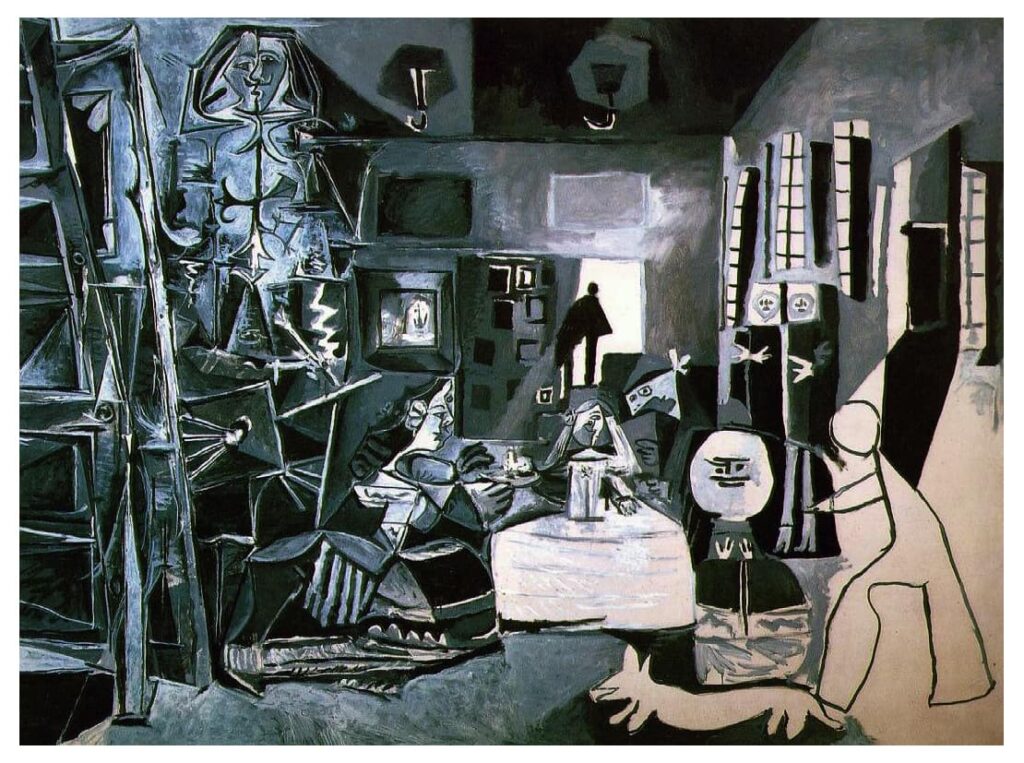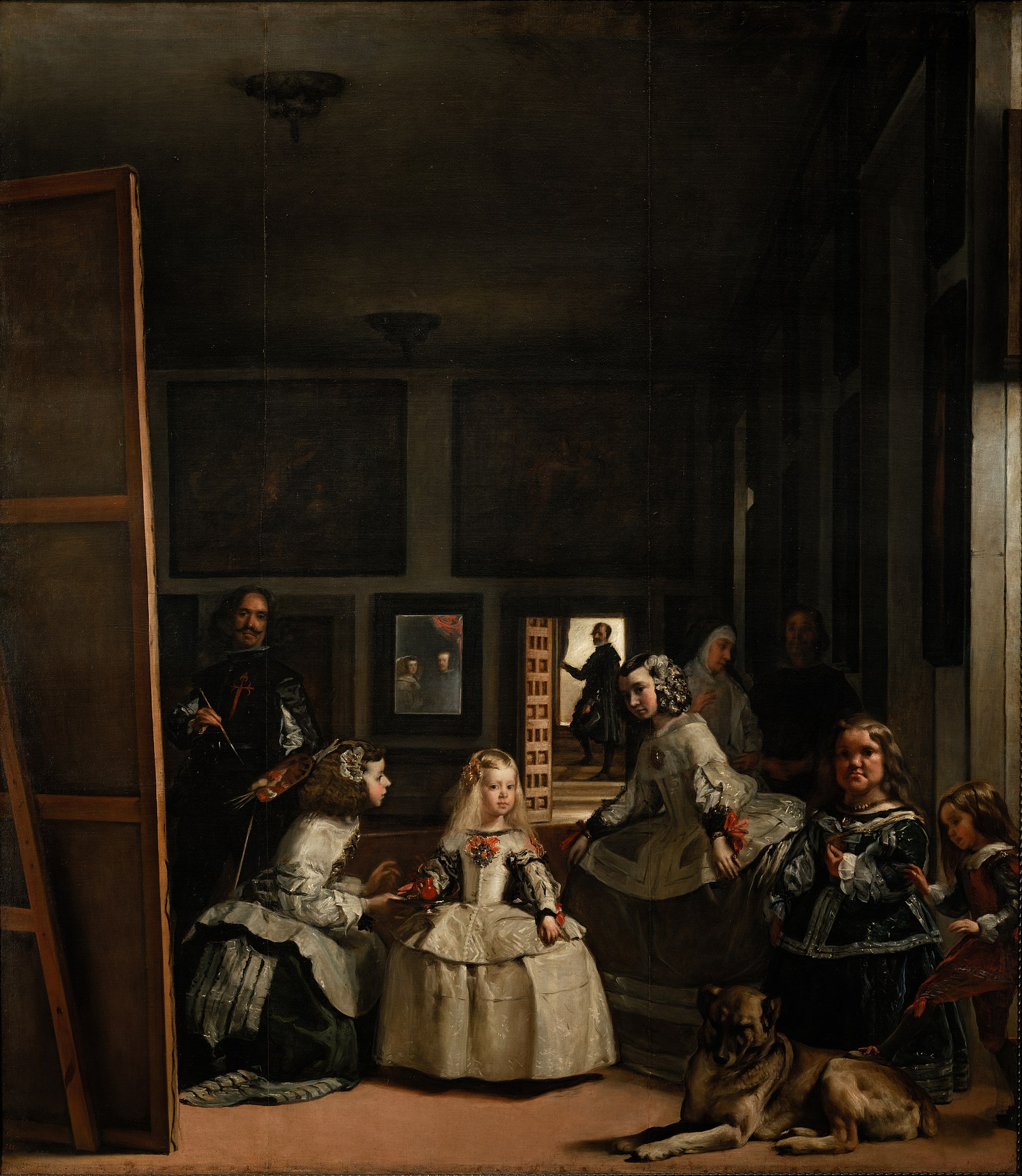Las Meninas, the painting above, is (SpanLas Meninas (Spanish for ‘The Ladies-in-waiting'[a] pronounced [las meˈninas]) is a 1656 painting in the Museo del Prado in Madrid, by Diego Velázquez, the leading artist of the Spanish Baroque. It has become one of the most widely analyzed works in Western painting for the way its complex and enigmatic composition raises questions about reality and illusion, and for the uncertain relationship it creates between the viewer and the figures depicted.
Pablo Picasso was so fascinated by this painting, he created a total of 58 paintings, drawings, and studies based on Diego Velázquez’s Las Meninas in 1957.

This extraordinary series was Picasso’s most sustained engagement with a single work of art. He didn’t just reinterpret Las Meninas once—he deconstructed and reassembled it over and over, exploring its structure, characters, and spatial tensions in his own visual language.
Here’s a breakdown:
- 45 reinterpretations of the full Las Meninas scene or its major groupings.
- 9 additional studies focusing on individual characters like the Infanta Margarita or the dwarfs.
- 3 still lifes, painted concurrently and considered part of the series.
- 1 portrait of a pigeon, included because Picasso painted it while working on the Las Meninas series in his studio.
Where are they now?
All 58 works are housed together at the Museu Picasso in Barcelona, which is the only museum with such a complete and cohesive series from Picasso’s later years. It was donated by the artist’s widow, Jacqueline Roque, and Picasso’s secretary, Jaume Sabartés.
Why did Picasso do it?
Picasso wasn’t copying Velázquez—he was wrestling with him. The series is a dialogue across centuries, a deep dive into the nature of representation, power, space, and the role of the artist. He breaks apart Velázquez’s spatial logic, simplifies and exaggerates forms, and injects his own irreverent energy.
It’s Picasso engaging directly with one of the greatest painters of the Spanish tradition—and proving that modernism could stand toe-to-toe with the Old Masters.
Pablo Picasso didn’t emerge from nowhere. While he’s often described as a singular genius who reshaped modern art, his path was built on decades—and centuries—of influence. From Spanish masters to African sculpture, from Cézanne to Braque, Picasso was a master of synthesis. He devoured visual languages, broke them apart, and rebuilt something entirely new. Understanding who and what influenced him reveals not just where Picasso came from—but why his art still hits with such force.
Here’s a closer look at the artists, traditions, and cultures that helped shape Picasso’s vision.
1. The Spanish Masters: Goya, Velázquez, El Greco
Picasso grew up steeped in Spain’s rich painting tradition. As a child prodigy, he mastered classical draftsmanship quickly—but what stayed with him wasn’t just technique. It was the emotional depth and psychological tension of artists like:
- Francisco Goya, whose unflinching look at violence, war, and the grotesque planted early seeds for Picasso’s later political work (Guernica is unthinkable without Goya’s Disasters of War).
- Diego Velázquez, whose mastery of realism and spatial depth can be felt in Picasso’s lifelong obsession with Las Meninas.
- El Greco, whose elongated, expressive figures helped inspire Picasso’s early stylistic distortions and surreal spatial choices.
2. Symbolism and Post-Impressionism: Gauguin, van Gogh, Toulouse-Lautrec
When Picasso moved to Paris, he collided headfirst with the Symbolists and Post-Impressionists. They opened the door to emotional and psychological art—something more raw and subjective than naturalism.
- Vincent van Gogh’s emotional brushwork and tragic intensity can be felt deeply in Picasso’s Blue Period.
- Paul Gauguin’s flat color and “primitive” stylization pushed Picasso toward non-Western aesthetics.
- Henri de Toulouse-Lautrec’s depiction of urban life and performers influenced Picasso’s Rose Period, full of acrobats, harlequins, and outsiders.
3. Paul Cézanne: The Architect of Cubism
Cézanne was the foundational influence on Cubism. His reduction of natural forms into geometric shapes and his breakdown of traditional perspective gave Picasso and Georges Braque a radical new direction. Picasso took Cézanne’s ideas and blew them open—shattering form, flattening space, and birthing a new visual language.
Picasso famously said:
“Cézanne is the father of us all.”
4. African and Iberian Art: Masks, Sculpture, and the Non-Western Lens
In 1907, Picasso visited the ethnographic museum in Paris and saw African masks that changed his life. He realized these objects weren’t “primitive”—they were powerful, abstract, and spiritually charged. That encounter lit the fire for Les Demoiselles d’Avignon, one of the first great ruptures in modern art.
At the same time, Picasso drew from Iberian sculpture—ancient, stylized stone heads that offered a raw alternative to classical form.
These non-Western traditions freed Picasso from realism and pushed him into more symbolic, psychological, and radically simplified modes of representation.
5. Georges Braque: The Cubist Co-Creator
Though Picasso often gets the spotlight, Cubism was born from deep collaboration. Georges Braque brought structure and analytic rigor to their shared project. Together, they dismantled single-point perspective and reimagined how we see form and time. Their back-and-forth from 1908 to 1914 was one of the most important creative exchanges in art history.
6. Surrealism and the Avant-Garde
While Picasso never officially joined the Surrealist movement, he was aligned with its core ideas: the unconscious, dream logic, eroticism, and grotesque transformation. In the 1920s and ’30s, his work echoed Surrealist concerns—contorted bodies, symbolic violence, and primal sexuality.
Artists like Joan Miró, André Breton, and Salvador Dalí saw Picasso as a kindred spirit, a bridge between Cubist abstraction and the psychological intensity they pursued.
7. Folk Art, Children’s Drawings, and the “Untrained Eye”
Picasso was deeply interested in what he called “unlearned” or “raw” art. He collected children’s drawings, folk ceramics, and outsider art—not as novelties, but as proof that pure expression didn’t need academic training. This belief fed his late-period style, where he painted with speed, simplicity, and brutal honesty.
He once said:
“It took me four years to paint like Raphael, but a lifetime to paint like a child.”
Conclusion: Picasso the Absorber, Picasso the Alchemist
Picasso didn’t just borrow—he transformed. His genius wasn’t isolation, but integration. He took from the past and from the margins. He drew equally from African sculpture and Velázquez, from Cézanne and children’s drawings. He was never loyal to one school or tradition. His only loyalty was to innovation.
In understanding who shaped Picasso, we understand something bigger: modern art wasn’t a single rupture, but a long chain of bold acts—and Picasso was the link that ignited everything that followed.

